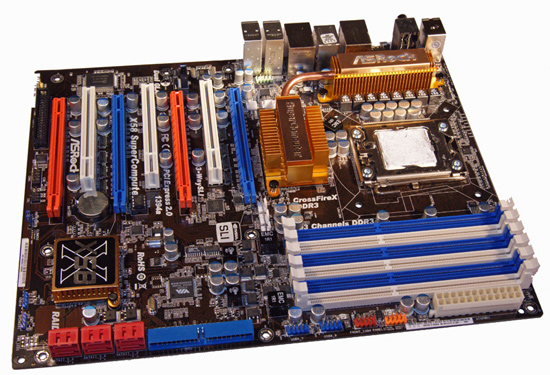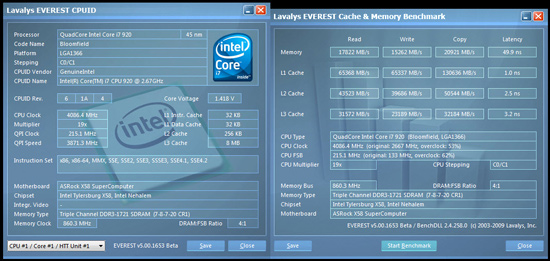
We had mentioned the ASRock X58 SuperComputer motherboard a couple of weeks ago and received numerous questions about it. We just wanted to provide a quick update today on our progress so far with the board. ASRock just released a new BIOS that has the board performing well. We have four NVIDIA GTX260-216 cards working on the board and performance is basically the same as boards with the NF200 bridge chipset in our test applications.
ASRock's Instant Boot technology is available on this board. Our average resume time (power off to desktop) has been right around six seconds. We really like this feature, although it does require a system reboot before the board powers down. ASRock offers power management via their Intelligent Energy Saver (IES) technology that is comparable to ASUS' EPU, MSI's DRMOS, and Gigabyte's DES programs. Average power savings at idle is around 5W and about 9W under load at this point. One of the more unique features on this board is that the eSATA port is self powered via a USB connector. This allowed us to utilize a eSATA/USB based SSD drive off the port.

Of course, if you are going to spend near $300 on a performance oriented motherboard, one of the first thoughts is how well does it overclock. Overclocking is now up to speed with BIOS 1.4 and stability has been excellent so far. We have asked ASRock to increase the VTT range in the BIOS and offer VDroop control along with a few other fine tuning requests. However, the board does overclock within the range of its competition as we reached a stable 19x215 or 20x205 with our retail i7 920.
We will have the full review of the ASRock X58 along with a look at several other mid-range X58 products shortly.
















9 Comments
View All Comments
Strouhal - Wednesday, March 11, 2009 - link
I think I want this board, but I also want a sound card (ASUS Xonar ftw) and the ability to SLI (two cards) if need be.Do new external soundcards need a PCIe slot, or can they be run in one of the PCI slots?
Do the orange PCIe slots function at x16 if there is nothing in the corresponding blue PCIe? Or do they not work at all? If I have a videocard in a blue and then put a soundcard in the corresponding orange, will that cut the blue down to x8?
Why do they advertise it as four x16 slots if their PCIe operation summary says that the orange slots can run at either x8 or nothing and the blues are cut down to x8 as soon as anything else is put into the corresponding orange?
All of these questions come about b/c I wanted to know if I could fit a soundcard and two Inno3d iChill GTX260 cards on it (gigantoid)...which I think would only work out if I could use the top blue and the bottom orange. each card takes up 3 slots worth of space...
Can't wait for your review! Thanks!
AsciiSmoke - Thursday, February 12, 2009 - link
Ahah! Thanks to your post; I've now found a premium brand alternative to the Asrock that meets my cooling needs. I think I'll go order an X58 Eclipse now.Cheers!
Nickel020 - Wednesday, February 11, 2009 - link
I really like these blog entries! Even if your testing never makes it into a full review that lives up to Anandtech's quality stnadards (whatever happed to the P35 roundup?), publishing your findings in the blog still helps out a lot of people and is quite informative.superkdogg - Wednesday, February 11, 2009 - link
What the hell is the ASUS going to sell for? $400?I'm almost surprised that Intel hasn't pushed partners to release something less extravagant in order to move some i7's.
Oh well, my C2D still works for what I need so until there's a value solution I'll be sitting on 775 like I did 939 for 5-6 years.
poohbear - Wednesday, February 11, 2009 - link
Asrock & $300 should not be in the same sentence mates. I thought it was the budget wing of Asus? how's $300 budget??AsciiSmoke - Wednesday, February 11, 2009 - link
To the best of my knowledge this board has a one-of-a-kind layout.I've recently upgraded to an SLi configuration and I found that my system was overheating because although my mobo has space for 3 cards there's not space between them for cooling. this is because there is a useless x1 slot at the top (which can't even accomodate a card becuse there's heat-pipes in the way)
The nice thing about this board is I can lay my cards in the following order:
Slot 1 - GPU #1
Slot 2 - Space for GPU #1's Fan
Slot 3 - Left blank so GPU #1 has a source of air
Slot 4 - Sound Card
Slot 5 - GPU #2
Slot 6 - Space for GPU #2's Fan
Slot 7 - Left blank so GPU #2 has a source of air
Why is this layout so rare, it makes perfect sense to me?
AsciiSmoke
samspqr - Wednesday, February 11, 2009 - link
a $300 board, however good it is, is not what I was expecting from Asrockwon't anybody make a no-bells-and-whistles-but-also-not-so-expensive core i7 board?
maybe the chipset itself is too expensive, but I know I won't pay more than 150eur for a board (and that would already be a big stretch, my most expensive board to date was 114eur, if I remember well)
Bremen7000 - Wednesday, February 11, 2009 - link
Hmm, so Instant Boot is just "reboot your system and then enter Sleep or Hibernate"?Ocire - Tuesday, February 10, 2009 - link
if you want to see a difference between x58 and x58+nf200, you should bench the raw pcie bandwidths of the individual slots and in concurrent operation.this can be easily done by disabling sli (so 3 or 4 single cards) and using the tools from the cuda zone and cuda forums at nvidia's website.
as you already mentioned, pure sli graphics operation doesn't seem to be pcie-bandwidth-bound, as there are no differences between nf200 and non-nf200. however, from a GPGPU standpoint, it's quite interesting to see the real bandwidths, as many of the programs using multiple (gp)gpus tend do have a lot of pcie transfers. (either gpu<->cpu or gpu<->gpu, which is in fact gpu<->cpu<->gpu as direct transfers are impossible)